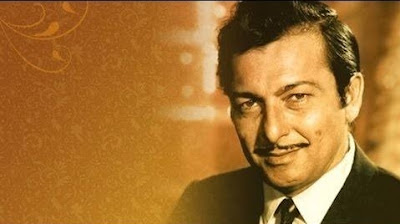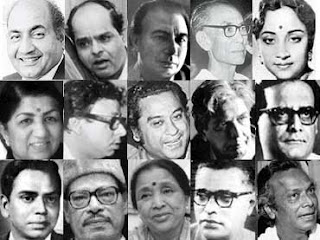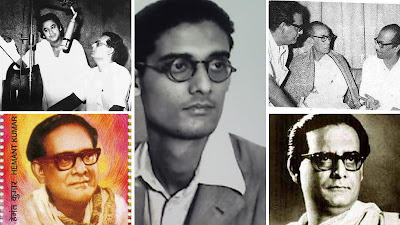PART 7 OF 10: MADANMOHANOMICS
I am going to make my next pit stop in the year 1962. It was a traumatic year for India. After electing Jawaharlal Nehru as Prime Minister for a third consecutive term (some would call that a traumatic event in itself), we got a nice whopping at the hands of our Chini bhais in the Indo-China War. Nehru never recovered from the deception from his favorite country, and passed away in the next couple of years, they say, an awfully sad man.
Back to our song list, I had not intended for this series to shape up to be a Rafi-Lata love-fest but that's what it has become. They were the biggest talents of that era, no doubt, but I was expecting for Kishore, Mukesh, Asha, and even Manna Dey to be well represented in my list of favorites. But then, I had to be honest with myself and choose numbers that I best liked and those that best represented the era. All of this build-up is only to exculpate myself for featuring Lata in the next two songs as well.
What can I say about Lata that has not been said before? The 'Swarkokila', 'The Nightingale of India', 'Bharat Ratna', winner of a zillion awards...you have already heard all of it before. Lata was born to a Marathi-Konkani father and a Gujarati mother. Her father was a musician and a theater actor, and her first guru. He died quite early due to heart disease and Lata being the eldest sibling was quite suddenly thrown into the ring to earn the livelihood for the family. She was just thirteen.
She recorded her first song in 1943, but it was not until 1949 that she got her big break with Khemchand Prakash’s 'Mahal' (who can forget 'Aayega Aanawala'!). There was no looking back from then on. However, it wasn't easy sailing for her during those six years. Composer Iqbal Haider was perhaps the only one that stood solidly behind her and promoted her. The others had all sorts of problems with her: some said her voice was too "thin", a few said she was copying Noorjehan, and others had a problem with her Marathi accent and her Urdu pronunciation (Dilip Kumar, for instance). Lata was undaunted by the naysayers. She deepened her knowledge of Hindustani classical, nurtured her own distinct style of singing, and brushed up her Urdu diction.
I am not going to further wax eloquent on her greatness (lest it get to her head), but I will leave matters to settle with this little factoid. Amidst her busy days as a playback singer, Lata led a secret night life that very few knew about. Before you start imagining her in catsuits and masks, it was about her little-known avatar as a music composer with the pseudonym, Anand Ghan. She did not reveal this for a long time till she was forced to come up on stage, during a Marathi awards function. I had lamented, in a previous chapter, about the underrepresentation of women as music composers. Imagine how much on an inspiration Lata could have been if she had taken her role as music composer seriously. In the seventies, Hrishikesh Mukherjee is said to have approached her to compose music for 'Anand'. Thankfully, Lata refused. That sounds mean, but 'Anand' is a musical masterpiece and Ram Gopal Varma will tell you that it is best to leave masterpieces alone. When it is a toss up between upholding inclusion & diversity, even with a legend like Lata on one side, and Salil Chowdhury and 'Anand' on the other, I will go with Salil Chowdhury. Just this one time. Sorry.
I thought it apt to discuss Lata in this chapter because the song I will be featuring was a result of her collaboration with a person she termed the 'Shehzada of Ghazals'. His name was Madan Mohan. I am going to stick my neck out and say this: Lata had some of her best solos recorded in her entire career, with Madan Mohan. I will go a step further. If you were to jot down your Top 10 Lata solos list, Madan Mohan would feature in half of them. That is a tall claim to make about the legacy of someone that has recorded 30,000 songs over seven decades in every language on the rupee note. But I know my constitutional rights and duties, and I make that claim with full awareness. Madan Mohan was that good.
He was born in Baghdad as his father was stationed there and worked for the Iraqi police. He returned to his native town in current-day Pakistan in the early nineteen-thirties. After some major town-hopping and stints in the Indian Army during World War II, and All India Radio where he got a chance to hobnob with the likes of Talat Mahmood and some serious Lucknowi Ustads, he pursued his passion for music in Bombay.
He debuted with 'Ankhen' (1950) and scored hits with 'Dastak', 'Adaalat', 'Woh kaun thi', 'Anpad', 'Chirag' and others. While he had a great association with Rafi and Manna Dey, it is his collab with Lata that brought out the best in him (the effect was mutual): 'Lag jaa gale', 'Rasm-e-ulfat ko nibhaaye', 'Joh humne dastaan apni sunayi', 'Naina barse rim jhim', 'Teri aankhon ke siwa duniya mein'...I can go on and on.
It is a sad reality that he was overshadowed by the musical giants of that era. It didn't help that the big heroes and directors had their musical cliques and didn't look beyond that to give the likes of Madan Mohan a chance. He struggled to cope up with this fact and was said to have taken up to drinking. He died early (he was just 51) due to liver cirrhosis but not before scoring music for nearly a hundred movies and leaving us with a rich legacy of ghazals and melodies. The song I want to feature here is 'Aap ki nazaron ne samjha' from the 1962 movie 'Anpadh', with lovely lyrics by Raja Mehdi Ali Khan. Watch it for Lata's ethereal voice and Mala Sinha's dazzling presence. Dharam paaji looks like fish out of water in this song. Poor guy. He had made his name in the sixties playing romantic second-leads to famous heroines, such as Meena Kumari and Nutan. It wasn't till he started drinking his enemies' blood that he became too 'Garam' to handle.










Comments
Post a Comment